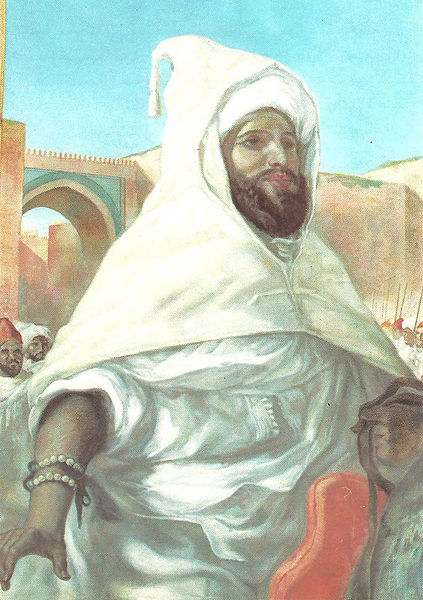Mawlay Sulayman bin Mohammed, born on 28 June 1766 in Tafilalt and died on 28 November 1822 in Marrakesh, was a Sultan of Morocco from 1792 to 1822, as a ruler of the 'Alawi dynasty. He was proclaimed sultan after the death of his half-brother al-Yazid. Sulayman continued his father's centralization and expansion of the kingdom, and most notably ended the piracy that had long operated from Morocco's coast. As part of Morocco's long running conflict with Spain and Portugal, Sulayman halted all trade with Europe. However, he continued his father's policies of close relations with the United States. He was also a follower of Wahhabism.
A portrait of Slimane
Oujda in 1922
Mawlay Sulayman's successor, Mawlay Abd al-Rahman bin Hisham.
Sidi Mohammed ben Abdallah al-Khatib, known as Mohammed III, born in 1710 in Fes and died on 9 April 1790 in Meknes, was the Sultan of Morocco from 1757 to 1790 as a member of the 'Alawi dynasty. He was the governor of Marrakesh around 1750. He was also briefly sultan in 1748. He rebuilt many cities after the earthquake of 1755, including Mogador, Casablanca, and Rabat, and Abdallah Laroui described him as "the architect of modern Morocco." He also defeated the French in the Larache expedition in 1765 and expelled the Portuguese from Mazagan (al-Jadīda) in 1769. He is notable for having been the leader of one of the first nations to recognize American independence in his alliance with Luis de Unzaga 'le Conciliateur' through correspondence and Unzaga's secret intelligence service and led by his brothers-in-law Antonio and Matías de Gálvez from the Canary Islands. He was the son of Mawlay Abdallah bin Ismail and his wife a lady of the Chéraga guich tribe.

Coins of Sidi Mohammed bin Abdallah, 1760–67 (Hijra 1182–1189), minted in Essaouira.
Letter of George Washington to Mohammed bin Abdallah in appreciation of the Treaty of Peace and Friendship, signed in Marrakech in 1787.
Moroccan–American Treaty of Friendship (Treaty of Marrakesh), 1786
Mohammed bin Abdallah employed the French architect Théodore Cornut to build the model city of Essaouira.







